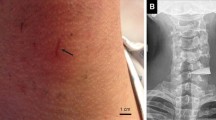Abstract
Background
The retained knife blade is an unusual and spectacular injury. The aim of this study was to review our experience with the management of such injuries.
Methods
A retrospective chart review of patients with retained knife blades treated at Groote Schuur Hospital Trauma Centre from January 1996 to December 2007 was undertaken.
Results
Thirty-three patients with retained knife blades were identified. Site of wound entry was the thorax in 13 patients (40%), the neck and back in 7 patients (21%) each, upper and lower extremities in 4 (12%), and the face and abdomen in 1 patient (3%) each. Thirty patients (91%) were hemodynamically stable on admission; two (6%) presented with wound abscesses, and one patient (3%) with active bleeding required emergency surgery. All 33 blades were extracted after clinical and radiological assessment. Simple withdrawal of the blade was possible in 19 cases (58%) and the likelihood of post-extraction bleeding was only 5%. Thirteen patients (40%) required an open surgical approach through dissection of the entry wound, laparotomy, or thoracotomy. Video-assisted thoracoscopic removal was used in one case. Retained thoracic blades were significantly associated with postoperative sepsis (P = 0.0054). There were no deaths.
Conclusions
All impacted knife injuries require careful clinical and radiological assessment. Simple withdrawal can be performed safely in the emergency room provided potential life-threatening vascular and solid organ injuries have been excluded. There should be a low threshold for investigating and treating patients with retained intrathoracic blades for postoperative sepsis.
Similar content being viewed by others
References
Hanoch J, Feigin E, Pikarsky A et al (1996) Stab wound associated with terrorist attacks in Israel. JAMA 276:388–390
Wilson A, McNatt S (2006) A unique zone II neck injury. J Trauma 60:1378
Frangos SG, Ben-Arie E, Bernstein MP et al (2006) Thoracic stab wound with impaled knife. J Trauma 60:1379
Grobbelaar A, Knottenbelt JD (1991) Retained knife blades in stab wounds of the face: is simple withdrawal safe? Injury 22:29–31
Hudson DA (1992) Impacted knife injuries of the face. Br J Plast Surg 45:222–224
Daya NP, Liversage HL (2004) Penetrating stab wound injuries to the face. SADJ 59:55–59
Van Lierop AC, Raynham O, Basson O et al (2008) Retained knife blades in the ear, nose and throat: three cases. J Laryngol Otol 3:1–5
Taylor AG, Peter JC (1997) Patients with retained transcranial knife blades: a high-risk group. J Neurosurg 87:512–515
Thomson BN, Knight SR (2000) Bilateral thoracoabdominal impalement: avoiding pitfalls in the management of impalement injuries. J Trauma 49:1135–1137
Kelly IP, Attwood SE, Quilan W et al (1995) The management of impalement injury. Injury 26:191–193
Madhok BM, Roy DD, Yeluri S (2005) Penetrating arrow injuries in Western India. Injury 36:1045–1050
Fingleton LJ (1987) Arrow wounds to the heart and mediastinum. Br J Surg 74:126–128
Karger B, Sudhues H, Kneubuehl BP et al (1998) Experimental arrow wounds: ballistics and traumatology. J Trauma 45:495–501
Navsaria PH, Vogel RJ, Nicol AJ (2004) Thoracoscopic evacuation of retained posttraumatic haemothorax. Ann Thorac Surg 78:282–286
Navsaria PH, Nicol AJ (2006) Video-assisted thoracoscopic pericardial window for penetrating cardiac trauma. S Afr J Surg 44:18–20
Bar I, Rivkind A, Deeb M et al (1998) Thoracoscopically guided extraction of an embedded knife from the chest. J Trauma 44:222–223
Burach JH, Amilraj EA (2005) Thoracoscopic removal of a knife impaled in the chest. J Thor Cardiovasc Surg 130:1213–1214
Williams CG, Haut ER, Ouyang H et al (2005) Video-assisted thoracic surgery removal of foreign bodies after penetrating chest trauma. J Am Coll Surg 202:848–852
Navsaria P, Maximilien T, Nicol A (2006) Foley catheter balloon tamponade for life-threatening haemorrhage in penetrating neck trauma. World J Surg 30:1265–1268
McCarthy T, Lassota-Korba B, O’Leary T et al (2007) Chest compressions for a patient in cardiac arrest after penetrating trauma with a knife still in situ. Emerg Med J 24:596–597
Lipp M, Mihaljevic V, Jakob H et al (1993) Fibreoptic intubation in the prone position. Anesthesia in a thoracoabdominal knife stab wound. Anaesthetist 42:305–308
Author information
Authors and Affiliations
Corresponding author
Rights and permissions
About this article
Cite this article
Sobnach, S., Nicol, A., Nathire, H. et al. Management of the Retained Knife Blade. World J Surg 34, 1648–1652 (2010). https://doi.org/10.1007/s00268-010-0514-4
Published:
Issue Date:
DOI: https://doi.org/10.1007/s00268-010-0514-4




